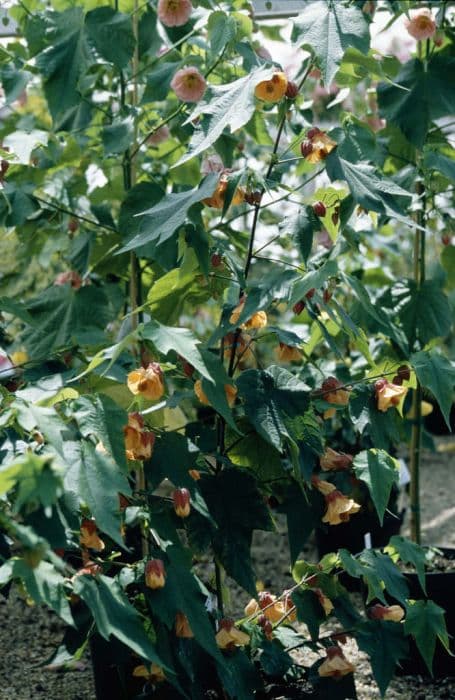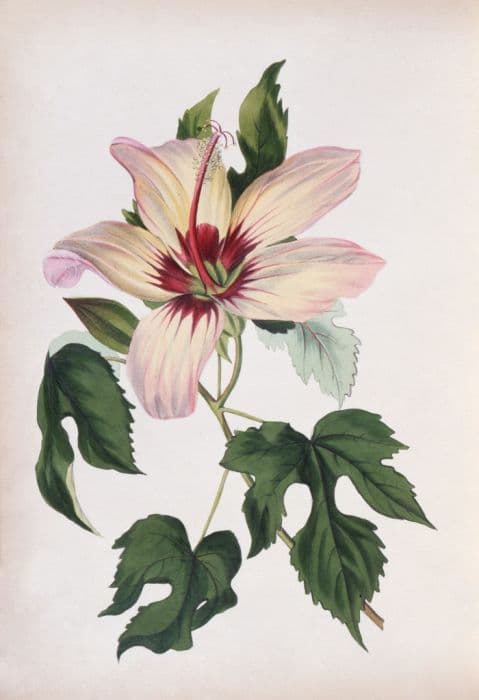Black-eyed Susan Hibiscus trionum

ABOUT
H. trionum is an upright annual, to 60cm tall, with oval, serrated leaves. The creamy-white or pale yellow flowers, with purplish-brown centres, are borne from late summer to early autumn and followed by bladder-like seed capsules
About this plant
 Names
NamesFamily
Malvaceae.
Synonyms
Flower-of-an-Hour, Bladder Hibiscus, Modesty, Shoogly, Venice Mallow, Puarangi, Shoofly.
Common names
Hibiscus africanus, Trionum annuum, Hibiscus pentacarpos, Ketmia trionum, Trionum trionum.
 Characteristics
CharacteristicsLife cycle
Annuals
Foliage type
Deciduous
Color of leaves
Green
Flower color
White
Height
2-3 feet (60-90 cm)
Spread
1-2 feet (30-60 cm)
Plant type
Herb
Hardiness zones
10
Native area
Mediterranean
Benefits
 General Benefits
General Benefits- Aesthetic value: Hibiscus trionum, often called Flower-of-an-Hour, adds visual interest to gardens with its distinctive flowers that bloom for a short time each day.
- Pollinator attraction: The plant is known to attract bees and other pollinators, which is beneficial for the ecosystem and nearby plants.
- Drought tolerance: Flower-of-an-Hour can tolerate periods of dry conditions, making it suitable for xeriscaping and water-conservation landscapes.
- Easy propagation: The plant readily self-seeds, which can be advantageous for gardeners who wish to naturally propagate the plant without much effort.
- Fast growth: Flower-of-an-Hour grows quickly, allowing for rapid establishment and filling in of garden areas.
- Wildlife habitat: It provides shelter and food for certain insects, contributing to biodiversity in the garden.
 Medical Properties
Medical Properties- Anti-inflammatory: Hibiscus trionum has been used traditionally to reduce inflammation.
- Analgelsic properties: It's been reported to have pain-relieving effects.
- Antipyretic use: The plant may be used to reduce fever.
- Diuretic effects: Hibiscus trionum is sometimes used to increase urine production.
- Wound healing: There are claims of its use in promoting the healing of wounds.
 Air-purifying Qualities
Air-purifying QualitiesThis plant is not specifically known for air purifying qualities.
 Other Uses
Other Uses- Hibiscus trionum's flower buds can be used in salads for a mild flavor and striking visual appeal.
- The fibrous stems of the plant have been traditionally used to craft twine or rope in some cultures.
- The flowers can serve as natural dyes for fabrics, yielding colors from pale yellow to greenish-yellow.
- Flower extracts are sometimes incorporated into cosmetics for their colorant properties.
- The plant is occasionally used in ornamental landscaping for its attractive flowers and rapid growth.
- Parts of Hibiscus trionum can be used in crafting herbal sachets for their subtle fragrance and aesthetic value.
- The petals are sometimes used in the paper-making process to create decorative, artisan paper.
- In educational contexts, Hibiscus trionum can serve as a model plant for studying botany and flower development.
- The plant can act as a temporary ground cover to suppress weeds in garden beds due to its fast-growing nature.
- Some people use the juice extracted from the leaves as a natural insecticide to protect other plants in the garden.
Interesting Facts
 Feng Shui
Feng ShuiThe Hibiscus is not used in Feng Shui practice.
 Zodiac Sign Compitability
Zodiac Sign CompitabilityThe Hibiscus is not used in astrology practice.
 Plant Symbolism
Plant Symbolism- Beauty: The Hibiscus trionum, commonly known as the Flower-of-an-Hour, is renowned for its attractive blooms, symbolizing delicate beauty.
- Fleeting Moments: Since its flowers often only last for a short time, usually a single day, it represents the fleeting nature of beauty and moments in life.
- Carpe Diem: Linked to its transient flowers, it also symbolizes the "seize the day" philosophy, encouraging one to cherish every moment.
- Invitation to Celebrate: In some cultures, the Flower-of-an-Hour's vivid colors and striking appearance serve as an invitation to celebrate life's joyful events.
- Ephemeral Delights: This plant can represent the fleeting pleasures of life, urging a deeper appreciation for short-lived joys.
 Water
WaterFlower-of-an-hour (Hibiscus trionum) should be watered deeply, ensuring moisture reaches the root zone without making the soil waterlogged. During the growing season, water approximately once a week with one to two gallons, depending on the size of the plant and the weather conditions. Always check the soil before watering; the top inch should be dry to the touch. Reduce watering in the winter months when the plant is not actively growing. Note that container-grown plants may require more frequent watering than those in the ground.
 Light
LightFlower-of-an-hour thrives in full sun to partial shade. The ideal spot is one where the plant receives at least six hours of direct sunlight per day. If grown indoors, a south-facing window would provide the appropriate light conditions for optimal growth. Avoid deep shade, as this can lead to poor flowering and leggy growth.
 Temperature
TemperatureFlower-of-an-hour prefers warm conditions and is best suited to environments with temperatures between 60°F and 90°F. It can survive minimum temperatures down to about 45°F but will not tolerate frost. The ideal range for active growth and flowering lies within 70°F to 85°F. Ensure to protect the plant from cold drafts and sudden temperature fluctuations.
 Pruning
PruningPruning flower-of-an-hour is typically done to maintain shape and remove spent flowers or damaged stems, which encourages further blooming and healthy growth. Prune lightly throughout the growing season to remove dead or yellowing leaves and trim back any overgrowth. The best time to perform extensive pruning is in the early spring before new growth begins.
 Cleaning
CleaningAs needed
 Soil
SoilFor Flower-of-an-Hour (Hibiscus trionum), the best soil mix is well-draining with organic matter such as peat, compost, or well-rotted manure. A loamy to sandy loam soil type is ideal, with a pH range from slightly acidic to neutral (pH 6.0 to 7.0).
 Repotting
RepottingFlower-of-an-Hour should be repotted every 2-3 years or when it outgrows its current pot. Spring is the best time to repot to minimize stress on the plant.
 Humidity & Misting
Humidity & MistingFlower-of-an-Hour thrives in moderate to high humidity levels, ranging from 40% to 70%. Avoid placing it in overly dry conditions to maintain plant health.
 Suitable locations
Suitable locationsIndoor
Provide bright light, well-draining soil, and regular watering for indoor Flower-of-an-Hour.
Outdoor
Plant in sun to part shade and well-draining soil for outdoor Flower-of-an-Hour.
Hardiness zone
2-11 USDA
 Life cycle
Life cycleHibiscus trionum, commonly known as the Flower-of-an-Hour, begins its life cycle from a hardy seed that germinates in spring when soil temperatures are warm. After seedling emergence, the plant develops a root system and a rosette of leaves during the vegetative stage. As the plant matures, it grows upward forming a branched stem and starts developing flower buds. Flowering typically occurs in the summer, featuring short-lived, delicate, yellow with a dark center blossoms that open for only a few hours, usually in the morning. After pollination, possibly by bees or other insects, the plant produces seed capsules, and once mature, they dehisce to release seeds for the next generation. Completing its life cycle, the Flower-of-an-Hour is an annual plant, and it dies after seed maturation, relying on the new seeds to propagate the species.
 Propogation
PropogationPropogation time
Spring-Early Summer
The most popular method of propagating Flower-of-an-Hour, or Hibiscus trionum, is through its seeds. For successful germination, the best time to sow the seeds is after the last frost in spring to early summer when the soil has sufficiently warmed up. The seeds can be directly sown into well-draining soil at a depth of about 1/4 inch (approximately 6 millimeters). They typically require full sunlight and should be kept moist until germination, which usually occurs within 2 to 3 weeks. Sowing the seeds in the desired location avoids the risk of transplant shock, as Flower-of-an-Hour does not always respond well to being moved once established.









